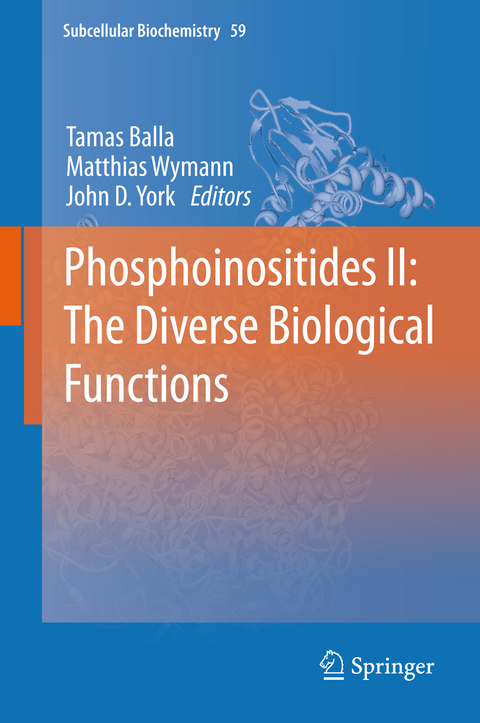
Phosphoinositides II: The Diverse Biological Functions
Springer (Verlag)
978-94-007-9551-8 (ISBN)
Volume II extends into the role of phosphoinositides in membrane organization and vesicular traffic. Endocytosis and exocytosis are modulated by phosphoinositides, which determine the fate and activity of integral membrane proteins. Phosphatidylinositol(4,5)-bisphosphate is a prominent flag in the plasma membrane, while phosphatidylinositol-3-phosphate decorates early endosomes. The Golgi apparatus is rich in phosphatidylinositol-4-phosphate, stressed cells increase phosphatidylinositol(3,5)-bisphosphate, and the nucleus has a phosphoinositide metabolism of its own. Phosphoinositide-dependent signaling cascades and the spatial organization of distinct phosphoinositide species are required in organelle function, fission and fusion, membrane channel regulation, cytoskeletal rearrangements, adhesion processes, and thus orchestrate complex cellular responses including growth, proliferation, differentiation, cell motility, and cell polarization.
1. Ca2+ signalling by IP3 receptors. - 2. Phosphoinositide signaling during membrane transport in Saccharomyces cerevisiae. - 3. Phosphoinositides in the mammalian endo-lysosomal network. - 4. Role of PtdIns(4,5)P2 in vesicle exocytosis and membrane fusion. - 5. Role of phosphoinositides at the neuronal synapse. - 6. Phosphatidylinositol 4,5-bisphosphate and the actin cytoskeleton. - 7. Phosphoinositides in chemotaxis. - 8. Phosphoinositides in Golgi complex function. - 9. Sec14 like PITPs couple lipid metabolism with phosphoinositide synthesis to regulate Golgi functionality. - 10. Phosphoinositide sensitivity of ion channels, a functional perspective. - 11. Nuclear phosphoinositides: location, regulation and function. - 12. Phosphoinositides and cellular pathogens. - 13. Defining signal transduction by inositol phosphates. - 14. Cell signalling by inositol pyrophosphates.
| Reihe/Serie | Subcellular Biochemistry ; 59 |
|---|---|
| Zusatzinfo | XVI, 460 p. |
| Verlagsort | Dordrecht |
| Sprache | englisch |
| Maße | 155 x 235 mm |
| Themenwelt | Medizin / Pharmazie ► Medizinische Fachgebiete ► Neurologie |
| Studium ► 2. Studienabschnitt (Klinik) ► Humangenetik | |
| Naturwissenschaften ► Biologie ► Biochemie | |
| Naturwissenschaften ► Biologie ► Humanbiologie | |
| Naturwissenschaften ► Biologie ► Zellbiologie | |
| Naturwissenschaften ► Biologie ► Zoologie | |
| Schlagworte | Kinase • Phosphatase • phosphoinositide • PI 3-kinase • PTEN |
| ISBN-10 | 94-007-9551-3 / 9400795513 |
| ISBN-13 | 978-94-007-9551-8 / 9789400795518 |
| Zustand | Neuware |
| Informationen gemäß Produktsicherheitsverordnung (GPSR) | |
| Haben Sie eine Frage zum Produkt? |
aus dem Bereich


